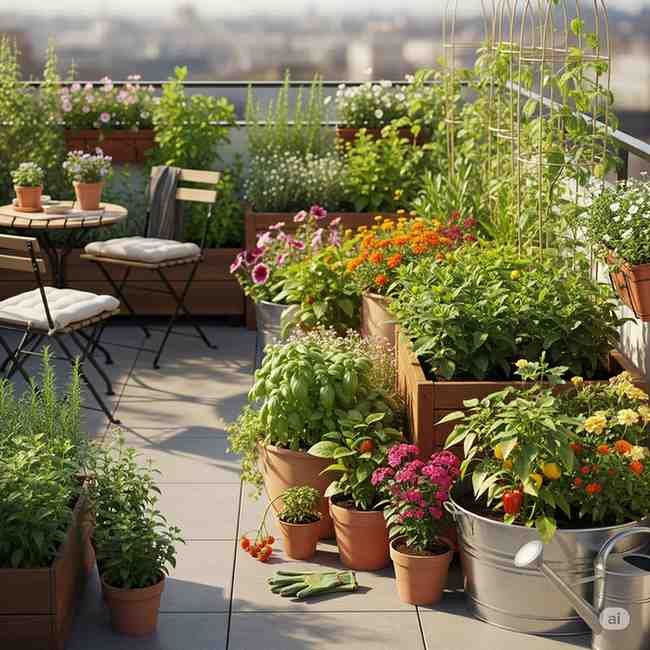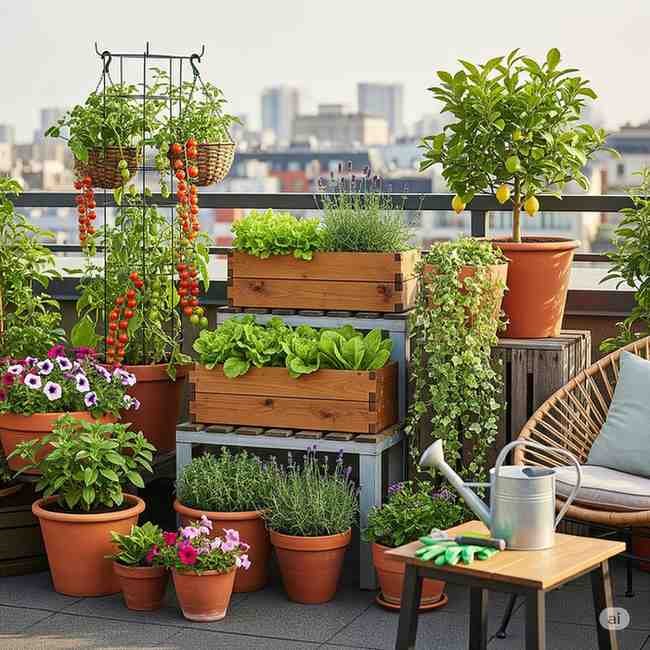
Terrace Gardening Complete Guide
Introduction to Terrace Gardening: Your Personal Oasis in the City
What exactly is terrace gardening? Its the art of cultivating plants—from vibrant flowers to delicious organic vegetables—on your rooftop or balcony. It’s about reclaiming your space from the urban sprawl and reconnecting with nature, all from the comfort of your home. Beyond the sheer joy of watching something you planted grow, a well-planned terrace garden offers a cascade of benefits that are particularly valuable for city dwellers.
* Fresh, Organic Produce at Your Fingertips: Imagine stepping out to harvest your own tomatoes, leafy greens, or fresh herbs for dinner. A rooftop vegetable garden gives you complete control over what you eat, ensuring your produce is free from pesticides and packed with flavor. It’s the ultimate farm-to-table experience, right on your terrace!
* Aesthetic Beauty & Mental Well-being: A lush, green space on your terrace is a visual treat and a powerful mood booster. The simple act of gardening—tending to your plants, feeling the soil, and observing nature—is a proven stress reliever. It transforms a sterile rooftop into a peaceful, personalized oasis where you can relax and recharge.
* Environmental Benefits for Your Community: Your urban garden is a small but mighty force for good. The plants on your terrace help to improve local air quality by absorbing pollutants, and they help reduce the urban heat island effect by providing shade and releasing moisture. Plus, planting local flowers attracts beneficial insects and pollinators, which are vital for a healthy ecosystem.
* Maximizing Underutilized Space in Urban India: For many of us in crowded cities, a terrace is our only chance to have a garden. Terrace gardening allows you to transform a previously unused or cluttered space into a productive and beautiful area, proving that you dont need a sprawling backyard to enjoy the bounty of nature.
Planning Your Terrace Garden: The Foundation for Success
Before you start digging, a successful rooftop garden design begins with careful planning. Think of me as your guide—I’ll help you assess your space like a seasoned pro to ensure your garden thrives. Getting these foundational steps right will save you a lot of time and effort in the long run.
1. Assessing Your Terrace: A Site Survey
Your terrace is unique, and its specific conditions will determine what you can grow. Don’t skip this critical step!
* Sunlight: Sunlight is the lifeblood of most plants. Spend a day on your terrace and observe where the sun hits and for how long. The golden rule is:
* Full Sun (6+ hours): Ideal for fruiting plants like tomatoes, peppers, and most flowers.
* Partial Sun (3-6 hours): Perfect for leafy greens, many herbs, and certain flowers.
* Shade: Your best bet for foliage plants and some shade-loving herbs.
* Pro-Tip: Take pictures at different times of the day (morning, noon, evening) to create a visual map of your sunlight patterns.
* Wind: Terraces are often exposed to strong winds, especially in high-rise buildings. Excessive wind can dehydrate plants quickly and even snap delicate stems. To combat this:
* Position taller plants and trellises against a wall to act as a natural windbreak.
* Group pots together to provide mutual protection.
* Consider hardy, wind-resistant plants like succulents, rosemary, or bougainvillea.
* Weight-Bearing Capacity: This is perhaps the most important safety consideration for terrace gardening in India. A single large pot with wet soil can weigh a significant amount. A collection of many pots, raised beds, and wet soil can place a heavy load on your roof.
* The Safe Approach: If you’re unsure about your building’s structural capacity, it is always best to check with a builder or structural engineer.
* Lighter is Better: To be safe, opt for lightweight pots (plastic, fabric grow bags) and a lighter soil mix. A mixture of cocopeat, compost, and perlite is significantly lighter than traditional garden soil and works beautifully for container plants. This also makes it a perfect solution for balcony gardens where weight is a major concern.
The Right Tools for the Job: Containers and Growing Media
Choosing the right pots and the perfect soil mix is the secret to a thriving terrace garden. A common mistake is to simply use regular garden soil, which can become heavy and compacted in a pot, suffocating your plant’s roots. As a horticulture scientist, I recommend a smarter approach.
Choosing Your Containers:
* Pots (Terracotta, Plastic, Ceramic): Traditional terracotta pots are beautiful and allow for great airflow, but they can be heavy and dry out quickly. Plastic and ceramic pots are excellent for retaining moisture and are lighter, making them ideal for rooftops where weight is a concern.
* Raised Beds: If you have a larger terrace, raised beds are a game-changer. They offer excellent drainage, reduce bending and back strain, and give you the feel of a traditional garden. They’re perfect for growing multiple vegetables together.
* Grow Bags: These are a modern marvel for urban gardening! Fabric grow bags are lightweight, portable, and their porous nature prevents overwatering by allowing excess moisture to evaporate. They are an incredibly popular and effective choice for growing everything from potatoes to herbs on a rooftop garden in India.
Creating the Perfect Growing Media:
Instead of just “soil,” you need a “potting mix.” This is a carefully balanced blend that provides air, drainage, and nutrients. Here’s a simple recipe for a lightweight and fertile mix:
* 1 part Garden Soil: The base.
* 1 part Cocopeat: This is a coconut husk fiber that makes the mix light and airy while helping it retain moisture. It’s a superstar ingredient!
* 1 part Vermicompost (or high-quality compost): This provides the essential nutrients and beneficial microbes your plants need to flourish.
* A handful of Perlite or Sand: This improves drainage and prevents the mix from becoming waterlogged.
This DIY potting mix for terrace garden is a low-cost, high-performance solution that will make your plants incredibly happy.
Watering and Drainage: The Lifeblood of Your Garden
Watering is both an art and a science. The key is consistency and efficiency.
* Manual Watering: This is the most common method and a wonderfully therapeutic daily ritual. To avoid overwatering, always check the moisture level of the soil with your finger. If it feels dry an inch or two below the surface, it’s time to water. Water at the base of the plant to prevent fungal diseases on the leaves.
* Drip Irrigation: For those with a busy schedule or a larger garden, a drip irrigation system for a home garden is a fantastic investment. These systems deliver water directly to the plant’s roots, minimizing evaporation and water wastage. They are highly efficient, eco-friendly, and a huge time-saver.
* The Importance of Drainage: This is non-negotiable! All containers must have drainage holes at the bottom. Without proper drainage, water collects at the bottom, leading to root rot—a death sentence for most plants. Placing your pots on pot feet or bricks to allow airflow underneath is a simple yet effective solution.
Choosing Plants for Your Terrace Garden in India: A Seasonal Guide
Now for the best part—stocking your garden! The beauty of terrace gardening in India is the incredible variety of plants that thrive in our diverse climate. Here’s a quick guide to get you started:
Vegetables Suitable for Indian Climates:
* Year-Round Champions: Tomatoes, brinjals (eggplant), chillies, bhindi (okra), and leafy greens like palak (spinach) are all fantastic choices. They’re prolific and relatively easy to grow.
* Summer Stars: Gourds like lauki (bottle gourd) and karela (bitter gourd) love the heat and can be trained to grow on a trellis, saving valuable floor space.
* Winter Wonders: As the temperature drops, you can grow a stunning variety of cool-weather veggies like carrots, radishes, peas, and cauliflower.
Fruits That Can Be Grown in Containers:
Don’t think you need an orchard to grow fruit! Many varieties of dwarf fruit trees thrive in large containers (20-25 inch pots).
* Citrus Trees: Dwarf lemon and lime trees are excellent choices. They are hardy, fragrant, and produce a bountiful harvest.
* Guava and Fig: These are also well-suited for container life and can be a rewarding addition to your rooftop food garden.
Herbs for Culinary and Medicinal Use:
Herbs are a must-have for any Indian kitchen garden. They are often low-maintenance and can be grown in small pots.
* Pudina (Mint) & Tulsi (Holy Basil): Both are incredibly easy to grow and have a wide range of culinary and medicinal uses.
* Coriander & Curry Leaves: Staples of Indian cooking, these can be grown fresh for a flavor boost in any dish.
Flowering Plants for Aesthetics and Pollinators:
Bring color and life to your terrace with flowers that also attract bees and butterflies!
* Marigolds: Hardy, beautiful, and known to deter pests.
* Hibiscus & Bougainvillea: These are classic choices for Indian climates, providing continuous blooms with minimal fuss.
* Jasmine: The fragrant blossoms of a jasmine plant will fill your terrace with a beautiful scent in the evenings.

Native & Low-Maintenance: The Smart Gardener’s Choice
When choosing your plants, think beyond the beautiful and consider the practical. Opting for native and low-maintenance plants is a game-changer for urban gardeners, especially in India’s varied climate.
* Native Plants: These are nature’s perfect solution for a sustainable garden. Since they have evolved to thrive in your specific climate, they naturally require less water, fertilizer, and pest control. Consider planting native beauties like Jasmine (mogra), which fills the air with its fragrance, or vibrant Hibiscus, which attracts pollinators. For a delicious edible option, the drumstick tree (Moringa oleifera) is a miracle plant that grows beautifully in a large container.
* Low-Maintenance Champions: These are the forgiving superstars of the plant world, perfect for busy urban lifestyles. Succulents and Cacti are a fantastic choice for sunny spots, requiring minimal watering. Hardy herbs like curry leaves (kadi patta) and rosemary are also incredibly resilient.
Setting Up Your Terrace Garden: Designing Your Oasis
A well-designed terrace garden layout is about more than just aesthetics—it’s about creating an efficient and enjoyable space. Here’s how to turn your terrace from a simple area with plants into a true sanctuary.
* Arranging Containers for Optimal Sunlight: Remember the sunlight survey we did? Now is the time to use that knowledge. Place your sun-loving vegetable and flower pots in the brightest spots, and tuck your shade-tolerant plants (like ferns or some leafy greens) in the corners or behind taller plants. Use multi-tiered plant stands to make sure every plant gets its share of the sun.
* Creating Pathways and Seating Areas: Even a small terrace can feel like a grand garden with a little planning. Lay down a simple pathway with stepping stones or wooden decking to guide foot traffic and keep your space organized. A small bench or a couple of comfortable chairs can transform your garden into a relaxing retreat, inviting you to spend more time enjoying your hard work.
* Vertical Gardening for Small Spaces: Don’t let a small footprint limit your dreams! Vertical gardening is a brilliant solution for urban terraces. Use trellises or bamboo stakes for climbing plants like gourds, beans, or even beautiful creepers like money plants. You can also mount planters on a wall to grow herbs and leafy greens, creating a stunning and space-saving “green wall.”
* Adding Support for Climbing Plants: As your vines and creepers grow, they’ll need support. Simple bamboo stakes or a DIY trellis from wooden slats work wonders. This not only keeps your plants from flopping over but also improves air circulation and maximizes your yield.
Caring for Your Terrace Garden: The Art of Nurturing
Your garden is now set up and looking beautiful. The final step is consistent, loving care. While it might seem daunting, it’s all about developing a simple, rewarding routine.
* Watering Techniques and Schedules: The key is to water deeply but infrequently. Instead of a light sprinkle every day, give your plants a thorough soaking. Do this either in the early morning or late evening to prevent rapid evaporation and reduce the risk of sun-scald on wet leaves. Always check the soil moisture before watering—overwatering is the most common cause of plant death!
* Fertilizing Your Plants: Potted plants need a little more help with nutrients because they are in a confined space. Fertilizing is essential for robust growth and a bountiful harvest.
* Organic Options: For a natural approach, add a handful of vermicompost or your own kitchen compost to the soil every 3-4 weeks. You can also use a liquid fertilizer like a homemade compost tea or Jeevamrut, a potent organic nutrient mix that’s very popular in India.
* Inorganic Options: If you prefer, a balanced NPK fertilizer (like a 10-10-10 mix) can be used. Just remember to use it sparingly and follow the package instructions to avoid “burning” your plants.
The Doctor’s Guide: Pest and Disease Management
In a healthy garden, pests are a natural part of the ecosystem. The goal isn’t to eradicate them completely, but to manage them using safe and effective methods. For your personal kitchen garden, I always advocate for an organic approach.
* Prevention is the Best Cure: The healthiest plants are the most pest-resistant. Ensure your plants get adequate sunlight, water, and nutrients. Regularly check the underside of leaves for any signs of trouble. A strong water spray can often dislodge common pests like aphids.
* Organic Remedies from the Kitchen: You don’t need harsh chemicals! My go-to solutions are simple and effective.
* Neem Oil Spray: This is a classic for a reason. A solution of neem oil, a drop of liquid soap, and water is a powerful organic insecticide and fungicide. Spray it on your plants every 7-10 days to keep pests at bay.
* Garlic-Chilli Spray: Pests hate the smell and taste of this concoction. A blend of crushed garlic, a few green chillies, and water, strained and sprayed, can act as a great repellent.
Pruning and Deadheading: The Art of Shaping
These two simple techniques are crucial for maintaining a beautiful and productive garden.
* Pruning: Think of pruning as a haircut for your plants. By trimming away old or leggy growth, you encourage the plant to grow bushier, stronger, and produce more flowers and fruits. For most plants, cut at a 45-degree angle just above a leaf node (the point where a leaf or stem grows).
* Deadheading: This is the process of removing spent or faded flowers. It’s a simple but vital task. By deadheading, you redirect the plant’s energy from producing seeds back into making more beautiful blooms, leading to a longer, more vibrant flowering season.
Seasonal Care Tips for India: Adapting to Our Climate
Our diverse climate brings unique challenges and opportunities. Here’s how to prepare your terrace garden in India for the seasons.
* Monsoon: The monsoon is a time of both joy and caution. Ensure your drainage is impeccable to prevent waterlogged roots. Move delicate plants under a covered area and be extra vigilant for fungal diseases, which thrive in high humidity.
* Summer Heat: The intense Indian summer requires extra care. Provide some afternoon shade for your plants, especially the leafy greens. Apply a layer of organic mulch (like dried leaves or coir) to the soil to help it retain moisture. Water deeply in the cooler hours of the early morning or late evening.
* Winter Chill: As temperatures drop, your plants will need protection. For cold-sensitive plants, move them to a sheltered corner or cover them with a cloth at night. Reduce your watering frequency as plants go into a semi-dormant state.
Design Ideas: Creating a Personal Haven
Your terrace garden is a reflection of your personality. A great terrace garden design enhances your space and makes you want to spend time there.
* The Relaxing Green Oasis: Create a tranquil retreat with soft lighting from fairy lights or solar lanterns. Add comfortable wicker chairs or a small swing. Use fragrant plants like Jasmine to fill the air with a soothing scent.
* The Functional Kitchen Garden: Design your space around food production. Use neatly arranged raised beds or grow bags for easy access to your vegetables and herbs. An organized, functional design is incredibly satisfying.
* Colors and Textures: Mix and match pots of different sizes and colors. Combine plants with varying leaf textures and flower colors for visual appeal.
* Decorative Elements: Add personal touches like wind chimes, small water features, or handcrafted sculptures to give your garden character.
Common Challenges and Solutions
* Yellowing Leaves: Often a sign of overwatering or nutrient deficiency. Check soil moisture and add some vermicompost.
* Drooping Plants: Usually a sign of underwatering, but can also be caused by root rot from overwatering. Feel the soil to confirm the problem.
* Lack of Flowers/Fruit: Often due to insufficient sunlight or a lack of phosphorus. Move the plant to a sunnier spot or add some bone meal to the soil.
Tips for Sustainable Terrace Gardening
* Compost, Don’t Waste: Start a compost pile with your kitchen and garden waste. It’s a goldmine of nutrients for your plants.
* Harvest Rainwater: Even a simple setup can collect rainwater, a pure and free source of water for your plants.
* Choose Local: Native plants are not only beautiful but also perfect for the local ecosystem.
Conclusion: Enjoying the Fruits of Your Labor
Congratulations! You’ve planned, built, and nurtured your own rooftop garden. The journey from a few seeds to a flourishing space is incredibly rewarding. The scent of blooming flowers, the taste of your homegrown tomatoes, and the peace of being surrounded by nature—these are the real treasures of terrace gardening.
Start small, learn from your plants, and most importantly, enjoy the process. Your terrace is no longer just a space; it’s a living, breathing testament to your patience and care. Happy gardening!
for more articles click here









